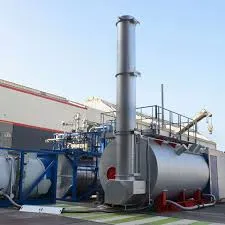
Sep . 25, 2024 09:23 Back to list
Designing a Hot Water Loop System for Steam Boilers in Industrial Applications
Understanding the Steam Boiler Hot Water Loop System
Steam boiler systems are widely used in industrial and commercial settings for generating heat, powering machinery, and providing hot water. A critical component of these systems is the hot water loop, which plays a vital role in efficiently distributing thermal energy throughout a facility. Understanding how steam boiler hot water loops operate can help in optimizing performance, enhancing energy efficiency, and reducing operational costs.
The Basics of Steam Boiler Operations
At its core, a steam boiler converts water into steam through high-temperature combustion processes. By heating water in a closed vessel, a steam boiler generates steam that can be used for various applications, including space heating, generating electricity, and supplying hot water. The primary types of boilers include fire-tube and water-tube designs, each having distinct advantages based on the application.
Once steam is generated, it is transported through insulated pipes to the desired point of use. After delivering heat, the steam condenses back into water and returns to the boiler. This cycle is essential for maintaining system efficiency and is managed through the hot water loop.
Components of the Hot Water Loop
A typical hot water loop in a steam boiler system consists of several key components
1. Pumps Circulating pumps are crucial in moving hot water from the boiler to the points of use. They ensure a steady flow and help maintain the desired temperature levels throughout the loop.
2. Heat Exchangers These devices are used to transfer heat between the steam and the water, allowing the system to produce hot water efficiently. Plate or shell-and-tube heat exchangers can be found in many systems.
3. Valves Control valves regulate the flow of water within the system, while check valves prevent backflow. They are essential for maintaining pressure and ensuring that hot water reaches its destination.
steam boiler hot water loop

4. Thermostats and Sensors Monitoring temperature and pressure within the loop is vital. These devices help maintain optimal operating conditions and can trigger alarms if anomalies arise.
5. Expansion Tanks As water heats up, it expands. An expansion tank accommodates this increase in volume, preventing excessive pressure buildup and potential damage to the system.
Advantages of a Hot Water Loop System
Implementing a hot water loop system in conjunction with a steam boiler offers numerous benefits
- Energy Efficiency By effectively capturing the heat from the steam and transferring it to the water, the system operates more efficiently, minimizing energy waste.
- Improved Comfort In heating applications, the controlled distribution of hot water ensures consistent temperatures throughout the space, enhancing comfort for occupants.
- Scalability The design of a hot water loop allows for easy expansion, making it adaptable to changing needs within a facility.
Conclusion
A steam boiler hot water loop is an essential component in many industrial and commercial heating systems. By understanding its operation and components, facility managers can make informed decisions on maintenance and optimization, leading to improved energy efficiency and reliability. Regular assessments and upgrades to the hot water loop can ensure it continues to meet operational demands while minimizing environmental impact and costs.
-
Best Steam Boiler Design PDF Free Design Calculation & Diagram Downloads
NewsJun.10,2025
-
Hot Boiler Water Heater Efficient Heating Solutions for Home & Commercial Use
NewsJun.10,2025
-
Steam Boiler Safety Devices High-Quality Protection Valves
NewsJun.10,2025
-
Ultimate Steam Boiler Checklist for Safety & Efficiency
NewsJun.10,2025
-
Optimal Hot Water Boiler Temperature Setting Guide
NewsJun.10,2025
-
Effective Hot Water Boiler Chemical Treatment Protect & Maintain
NewsJun.09,2025
Related PRODUCTS






















